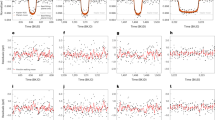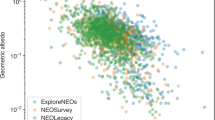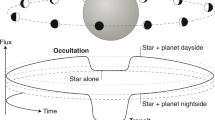Abstract
The assumption that the solar diameter is constant over periods that are short compared to the nuclear process has recently been questioned. In 1979 Eddy and Boornazian claimed that measurements of the solar diameter made at the Greenwich and US Naval observatories show a decrease of ∼2arcs, or 0.1%, per century over the period 1836–1953 (refs 1,2). Others have since extended this baseline by studying the evidence from Mercury transits3 and assessing the entire range of evidence from the beginning of the eighteenth century to the present4, and have found little or no evidence for a secular change in the solar diameter. Most recently, Ribes et al.5 have pushed the time baseline back to 1666, by considering the micrometer and transit measurements of the solar diameter made in Paris by Jean Picard (1666–82) and Philippe and Gabriel-Philippe de La Hire (1683–1719). Not only are these observations of importance for the investigation of solar changes at the end of the Maunder minimum, they can also be used for comparison with modern values. We discuss here the accuracy of Jean Picard's micrometer measurements of the solar diameter and his successors' transit measurements in light of the claim by Ribes et al.5 that these data provide evidence for a change in the apparent size of the Sun at the end of the Maunder minimum and a difference from the current size. Our evidence suggests that the necessary corrections to the measurement of sizes with early telescopes are larger than Ribes et al. assume. Therefore we call into question their conclusion that the Sun rapidly changed in size during this period.
This is a preview of subscription content, access via your institution
Access options
Subscribe to this journal
Receive 51 print issues and online access
$199.00 per year
only $3.90 per issue
Buy this article
- Purchase on Springer Link
- Instant access to full article PDF
Prices may be subject to local taxes which are calculated during checkout
Similar content being viewed by others
References
1. Eddy, J. A. & Boornazian, A. A. Bull. Am. astr. Soc. 11, 437 (1979); Phys. Today 32(9), 17-19 (1979). 2. Gilliland, R. L. Astrophys. J. 248, 1144-1155 (1981). 3. Shapiro, I. I. Science 208, 51 (1980). 4. Parkinson, J. H., Morrison, L. V. & Stephenson, F. R. Nature 288, 548-551 (1980). 5. Ribes, E., Ribes, J. C. & Barthalot, R. Nature 326, 52-55 (1987). 6. Alien, C. W. Astrophysical Quantities 3rd edn, 162 (Athlone, London, 1973). 7. Le Monnier, P. C. Histoire Celeste (Paris, 1741). 8. Auwers, A. Astro. Nachr. 128, 361-365 (1891). 9. Academic des Sciences, Paris Proces-Verbaux, 2, 50-58 (1667); printed in McKeon, R. M. Physis 13, 247-251 (1971). 10. Auzout, A. Traitedu Micrometre (Paris, 1667); reprinted in Memoires de I'Academic Royale des Sciences depuis 1666 jusqu'd 1699 vol. 7, part 1 (Paris, 1729). 11. McKeon, R. M. Physis 13, 250 (1971). 12. Auzout, A. Phil. Trans. R. Soc. 21, 373 (1667). 13. McKeon, R. M. Physis 13, 249-251 (1971). 14. Daumas, M. Scientific Instruments of the Seventeenth and Eighteenth Centuries (translated by Holbrook, M.) 113-114 (Praeger, New York, 1972). 15. Dunham, J. B., Dunham, D. W. & Fiala, A. D. Bull. Am. astr. Soc. 12, 832 (1980).
Author information
Authors and Affiliations
Rights and permissions
About this article
Cite this article
O'Dell, C., Helden, A. How accurate were seventeenth-century measurements of solar diameter?. Nature 330, 629–631 (1987). https://doi.org/10.1038/330629a0
Received:
Accepted:
Issue Date:
DOI: https://doi.org/10.1038/330629a0
This article is cited by
-
The Maunder Minimum and the Solar Dynamo
Solar Physics (2004)
-
Size of the Sun in the seventeenth century
Nature (1988)
-
Diameter of the Sun in AD 1715
Nature (1988)
Comments
By submitting a comment you agree to abide by our Terms and Community Guidelines. If you find something abusive or that does not comply with our terms or guidelines please flag it as inappropriate.



